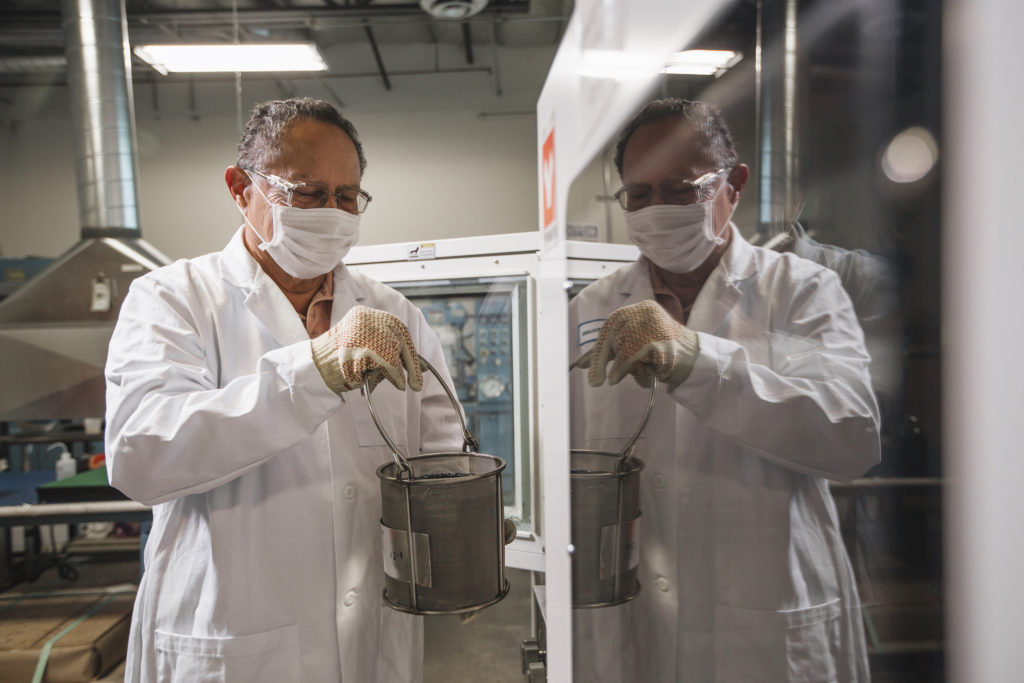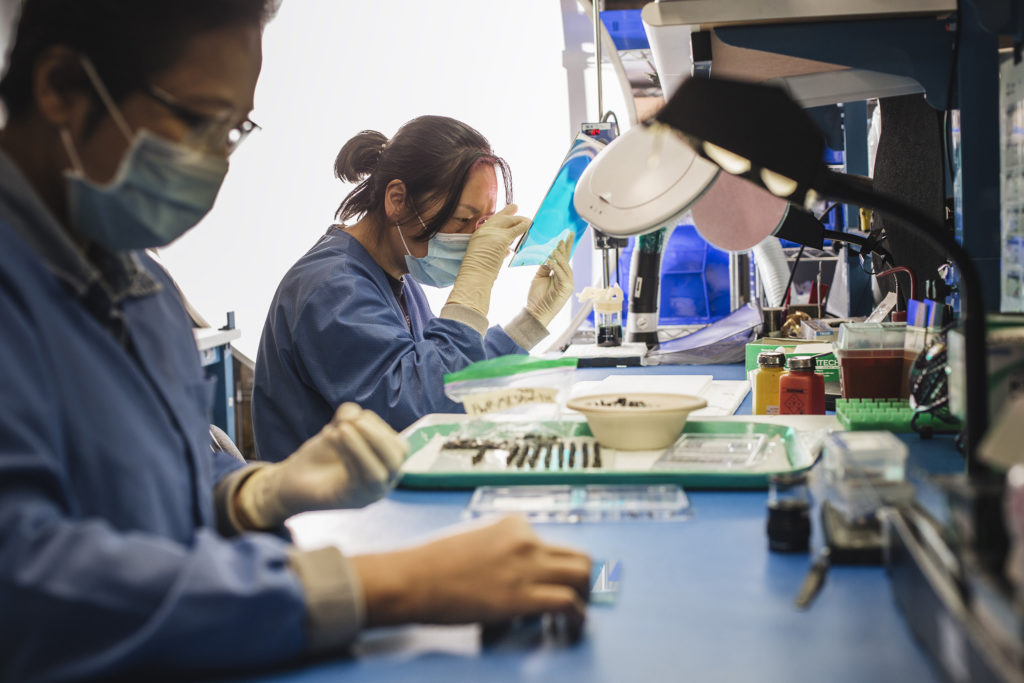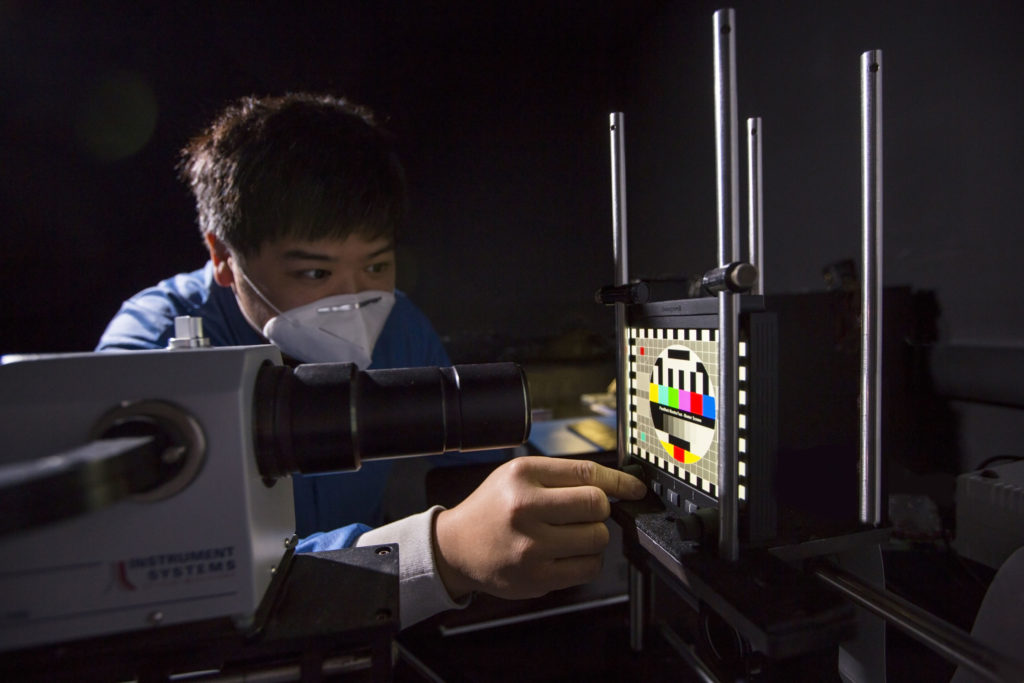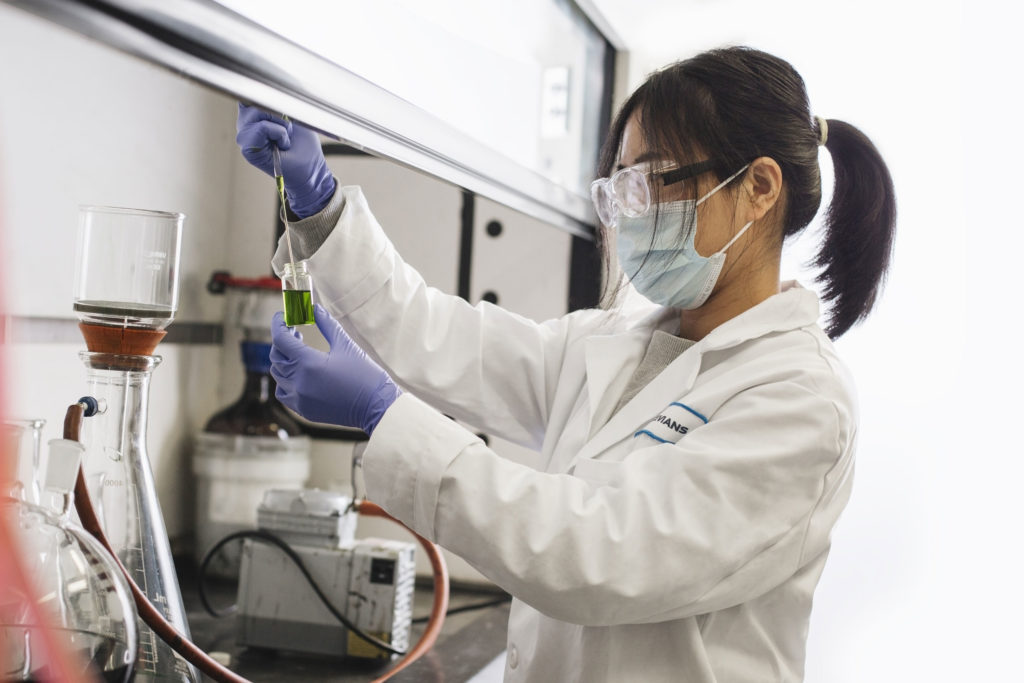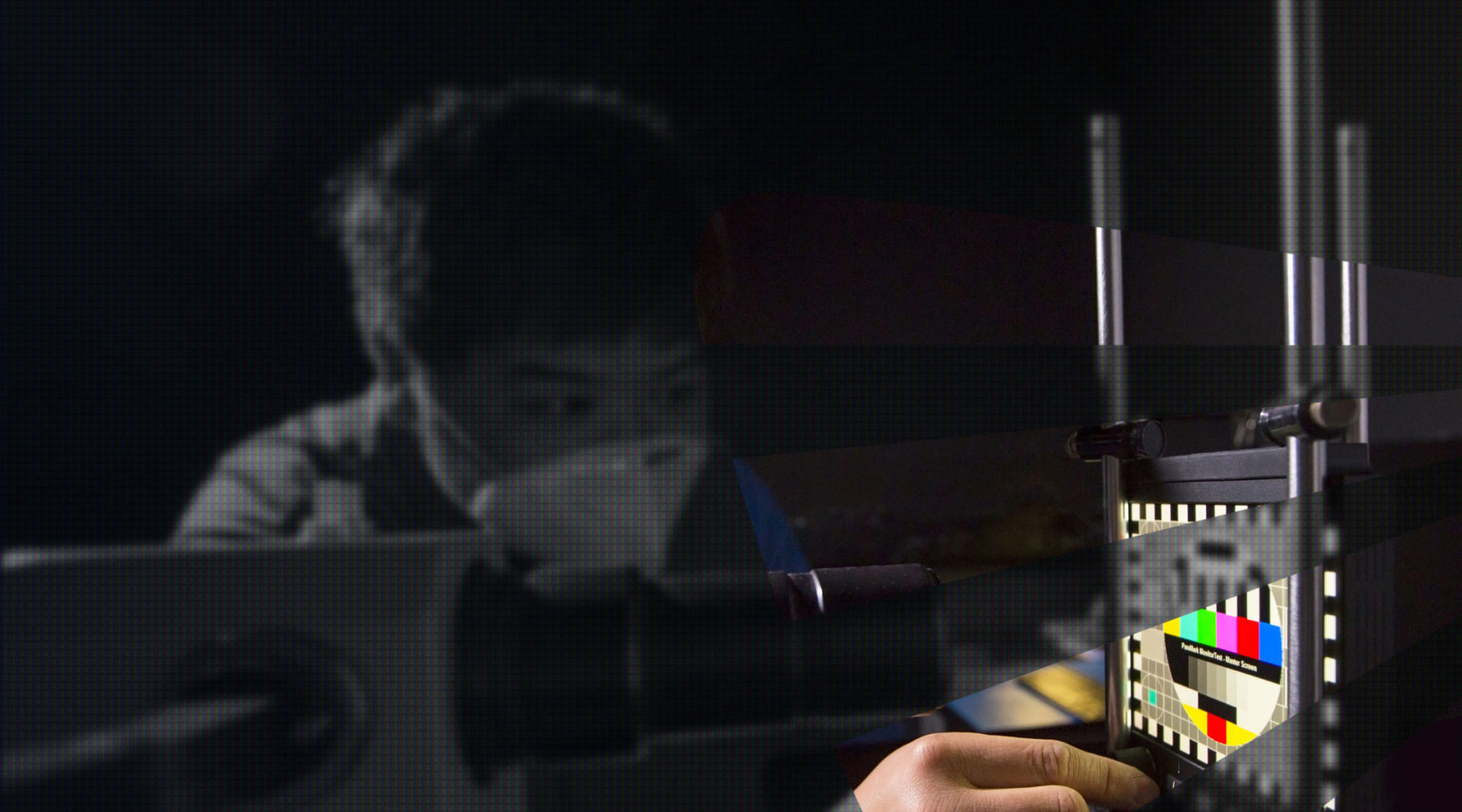
Capabilities
Scroll down
Chemical Synthesis
- Organic and inorganic synthesis
- Complex organic molecules
- Total synthesis via linear or convergent approaches
- Rapid scale-up and supply of scaffolds, building blocks, and intermediates up to kilo scale (non-GMP)
- Synthesis, isolation, and characterization of reference compounds using state-of-the-art techniques such as NMR, MS, Raman, and FTIR.
- Techniques such as LC-MS/MS and LC-MS using accurate mass measurement for material characterization
- One-pot multicomponent tandem polymerization reactions (MCTP)
- Variable temperature range from -90 to 300 °C
- Multi-step synthesis, multiple 5 gallons reactors
- Impurity profiling
- Molecular and chemical structure analysis
- Crystallization: nucleation, growth, oiling out, agglomeration, breakage, polymorphism chemistry
Polymer Processing
- Material formulation, controlling, internal diffusion, light transmission, surface finish, UV resistance, chemical compatibility
- Multiple high pressure, temperature controlled extruders, 10,000 psi, 300 degrees C
- Hot runner systems
- Knife gate valve deduster
- Dryers, annealing ovens
- Roll to roll lamination, 36”, hot/cold process
- Film extrusion, 36 “ width
- Injection molding, thermoplastic 15-25 T, insert molding, over-molding
- Sheet forming, 24”x 24”, 0.600” thick
- Polymer casting, urethane, PMMA
- Material finishing, die-cutting, laser marking and cutting, silk screening, CNC machining, coating (oleophobic, hard coating 7H+, antireflection coating, ITO coating, lamination, optical bonding, rubber stamping)
Glass Formulation
- Custom glass formulation
- Melting, small volume
- Cutting
- Double or single side polishing ranging from 24” to 56”, substrates from 3mm to 600mm
- Scribing 24”x24”
- Dicing 18”x24”
- Lapping
- Edge finishing, pencil, ground, chamfer
- Silkscreening
- Laser marking
- Machining
- Molding, low volume
Optical Spectroscopy
- Spectrophotometers, 175nm to 3.3um, 8 absorbent levels, variable slit width to 0.01nm minimal noise and stray light with double littrow monochromator, Schwarzschild coupling optics for high accuracy at low transmission levels, automatic goniometer for multiple angle measurements
- High sensitivity, high-speed, spectrometers, thermoelectrically cooled detectors, low stray light, 200-1,200nm with a high quantum efficiency
- Thermoelectric cooled spectrometer, near-infrared range up to 1,700nm, high resolution 1.7nm, high signal to noise ratio >1,500:1, low stray light <1.2%
- Automated goniometer spectrometers
- High speed, automated large area spectrometer, 200-1,200nm, <2 min, 36 points measurements
- Imaging colorimeter, cooled CCD sensor, 1,000,000:1 dynamic range, pixel array 4250 x 2838, luminance detection as low as 0.000 02 cd/m2, luminance repeatability within +/0.03%
- Photometric camera
- Automated large surface spectrophotometer
- Night vision goggles
- Haze meter, gloss meter
- Integrating spheres
- High ambient light contrast measurement, MIL-L-85762A
Testing Capabilities
- Solar radiation MIL-STD-810, Method 505.5 Procedure I, cyclic exposure, and Procedure II non-cyclic for actinic effects evaluation.
- Thermal shock, MIL-STD-810G. METHOD 503.5-7, Mil-Std 202G
- Thermal cycle, MIL-STD-883, 1010.8, Method 501.6,502.6
- Humidity method 507.6
- Altitude method 500.5-6 to 80,000 ft
- Salt fog method 509.6
- Electromagnetic compatibility MIL-STD-461G
- Abrasion ASTM D4060 - 19
- Scratch test ASTM D7027 – 20, ASTM G171 - 03(2017), ASTM C1624
- Impact resistance ASTM D256, ASTM D1822, ISO 7665-1, ASTM D5420-16
- Ball drop ASTM F3007 - 19
- Surface tension tensiometer, Young-Laplace equation, ASTM D971
- Immersion Method 512.6
- Peel strength actuation force ASTM D1876, ASTM D903-16
- Fluid contamination method 504.2
- Rain Method 506.6
- Fungus Method 508.7
- Sand and Dust Method 510.6
- Explosive Atmosphere Method 511.6
- Acceleration Method 513.7
- Vibration Method 514.7
- Acoustic Noise Method 515.7
- Shock Method 516.7
- Gunfire Shock Method 519.7
- Ballistic Shock Method 522.2
- Vibro-Acoustic/Temperature Method 523.4
- Mechanical Vibrations of Shipboard Equipment (Type I – Environmental and Type II – Internally Excited) Method 528.1
Optical Bonding
- OCR, automated process, thermal cure or UV cure, high precision bond thickness control.
- Materials available include custom modified acrylate, silicone, urethane, polyepoxides.
- OCA, automated pre-treatment and bonding process, silicones, urethanes and acrylates
- Surface treatment for high bond stress in extreme environmental conditions
- No Mura bond
- Processes suitable for glass-glass and glass-polymer bonds, compatible with thin film coatings
- Typical sizes range up to 27” for most processes and as large as 46” for specific materials
AMLCD Glass Fabrication
- Custom array design, aSi, and LTPS TFT, resolution up to 450 DPI
- TN or latest generation in-plane switching
- 0.3 to 0.7 mm glass substrate
- High transmission
- Custom color filter, 72% NTS
- Custom polarization orientation and film compensation
- Low specular reflection, < 0.7% with custom black mask geometry optical front film stack
- Wide temperature anisotropic liquid crystal fluid, clearing point >107 degree
- Custom cell gap construction
- Custom finish, chamfers, minimal non-active area
- Custom display interface board, with gamma control, health status, FPGA based
- Open selection of gate ICs
- Chip on glass or chip on flex
- Standard-fill or ODF
- Low minimum order quantity
- Low development cost
- Generation 3.5 fabrication factory
- Made in Japan
Thin-Film Coating
- Optical thin-film coatings 0.3 – 20 microns, plasma sputtering, and IAD Ebeam
- Products can be as large as 452 square inches.
- Experience with borosilicate, filter glasses, fused silica, sapphire, 1mm to 500mm
- Up to 99% passband transmission and OD 7 blocking over detector range
- FWHM 1-2% of CWL
- High uniformity over large surfaces
- Low sensitivity to angles of incidence (AOI)
- Environmental stability, no shift with humidity and temperature variation
- Durability MIL-C-48497A and Environmental MIL-STD-810F & MIL-STD-883
- Filter performance stable across temperature range -55°C to 150°C and thermal shock
Standard Coatings (0.3 – 20 microns)
- Antireflection
- Beamsplitters
- Conductive / Indium Tin Oxide (ITO)
- Dichroics
- Dielectrics
- Filters
- High reflection
- Metal/Protective
- Specialty and Custom Designed
Clean Manufacturing Environment
- Clean rooms, ISO 14644-1 Class ISO 3 and ISO 4
- Laminar flow clean stations, ISO 14644-1 ISO 5
- Automated aqueous ultrasonic clean line, multiple tanks, large capacity
- Dust-free surface modification treatment
Machining/Finishing
- CNC milling, router, lathe for metals and polymers
- Sandblasting
- Priming, painting, silk screening, rubber stamping, laser engraving
- Laser marking, cutting, CO2, YAG
- Stamping and die cutting
Engineering Tools
- Solidworks
- Mentor Graphics PADS-professional
- MTBF MIL-Handbook--217F prediction software
- Zemax OpticStudio, OpticsBuilder
- MiniTab
- GO-Optical simulation, transmission, chromaticity radiance
- Software Spectra, TFCalc
- Design to MIL-STD-1472, DO-160, MIL-STD810, MIL-STD-3009, MIL-L-85762, MIL-STD-704, MIL-STD-461, IP68, MIL-STD-202
- Ascalaph designer molecule designs
- Spartan-chemical structure
